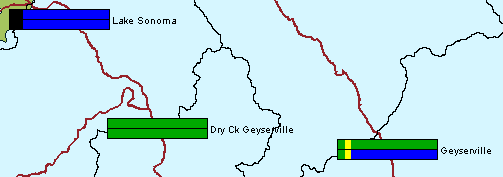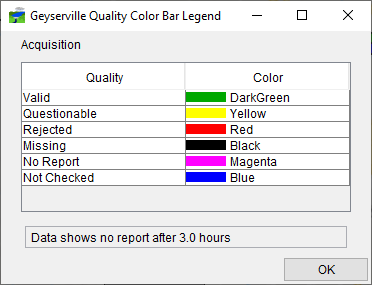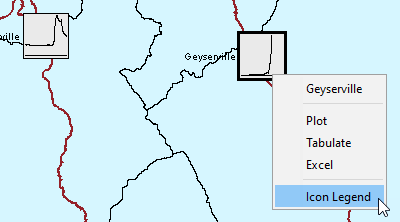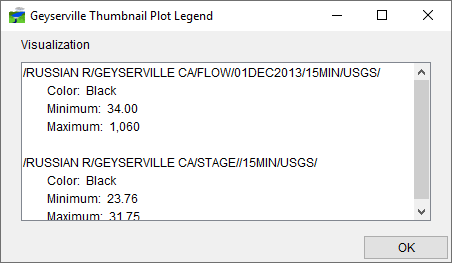Monitoring the quality of incoming data is the primary task during the data acquisition process. There are four primary ways for you to assess the quality of incoming data, to ascertain that your data streams are operational, and to identify specific locations with data problems.
- Quality color bars and thumbnail plots - give you a quick, visual overview of the data acquisition processes in the watershed during the specified time window.
- Plots and tables - provide detailed views of incoming data, helping you determine the nature of the issue.
- Data Summary Lists - allow you to view gages in groups (such as all precipitation or all flow gages) and see details for more or fewer gages than displayed in the georeferenced map window (Monitoring and Validating Incoming Data).
Quality Color Bars
Quality color bars offer a quick overview of data acquisition processes in the watershed, dynamically reflecting the status of incoming data at each location as being acceptable, missing, or questionable. CWMS attaches quality flags to the incoming data based upon thresholds that you set (see the CWMS Installation and Setup Manual).

A quality color bar is a thick, segmented line representing the history of the data quality at a specific location within the time window you have established. The name of the location appears adjacent to the color bar, and the length of the color bar represents a time line equal to the duration of the time window. Segments along the color bar reflect time intervals, with colors corresponding to the data quality legend you have defined. The quality color bars are updated dynamically at the time interval that you entered in the Time Window.
As part of your daily routine, you should review quality color bars to determine if the incoming data is good and whether or not the data needs to be validated.
Right-click on a time series icon in the Map Window and from the shortcut menu, select Icon Legend. The Quality Color Bar Legend dialog will open.

The legend displays the quality flags for the incoming data and the colors that represent each quality flag. To change the colors associated with the quality flags, see Configuring Quality Color Bars.
Thumbnail Plots
In some cases, you may wish to use thumbnail plots to represent gages and time series locations. Thumbnail plots provide a miniature plot of the actual data values, and allow the data manager to quickly see which gages are reacting to a hydrometeorological event. The name of the location appears adjacent to the thumbnail plot. The thumbnail plots are updated dynamically for the time interval that you entered in the Time Window.

To view the legend, right-click on a thumbnail plot and select Icon Legend from the shortcut menu. The Thumbnail Plot Legend dialog will open.

The legend displays the pathname, the color of the curve, and the minimum and maximum values of the curve. The Thumbnail Plot Legend dialog only provides information. To edit the color of the curve shown in the thumbnail plot, see Time Series Icons.